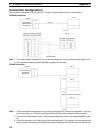
Appendix BCompoWay/F Master Protocol
147
2. When hexadecimal data is converted to ASCII data, data is sent starting from the send data word with
the largest offset. This is done because ladder programming handles data in 4-byte units.
1234
5678
Send data words Send frame
“56”“78”“12”“34”
Receive Data Word Allocation (3rd Operand of PMCR(260))
None. (Specify a dummy value for the operand, such as #0000.)
Send with No Conversion and with Response
(Sequence No. 602)
This sequence sends the specified data beginning with the command code to the specified Unit. The response is
stored starting at the specified word. No conversions are performed on the send and receive data.
Send Data Word Allocation (2nd Operand of PMCR(260))
Send data
First word of
send data
Number of send data words+0
+1
+2
+3
+4
(Undefined)
Node No.
MRC
SRC
Number of send bytes
Offset Contents (data format) Data
+0 Number of send data words
(4 digits BCD)
0005 to 0128
+1 (Undefined) Node No. (2 digits
BCD)
00 to 99
+2 MRC
(2 digits Hex)
SRC
(2 digits Hex)
Set the command code for the required
service
+3 Number of send bytes (4 digits BCD) Number of data bytes from the next byte
after the command code until the byte just
before the ETX.
0 to 492 decimal
+4
Send data
The data specified in hexadecimal here is
on
+0 +1
not converted and the number of bytes
+2 +3
specified in S+3 is sent.
+4 +5
+6 etc.
Receive Data Word Allocation (3rd Operand of PMCR(260))
Receive data
storage words
Number of receive data words+0
+1
+2
Response code
Receive data
Offset Contents (data format) Data
+0 Number of receive data words
(4 digits BCD)
0003 to 0128
+1 Response code (4 digits Hex) The response code will be stored in
hexadecimal form.
+2
Receive data (Hex)
The data from just after the response code
on
+0 +1
until just before the ETX is stored here
+2 +3
without conversion.
+4 +5
+6 etc.


















